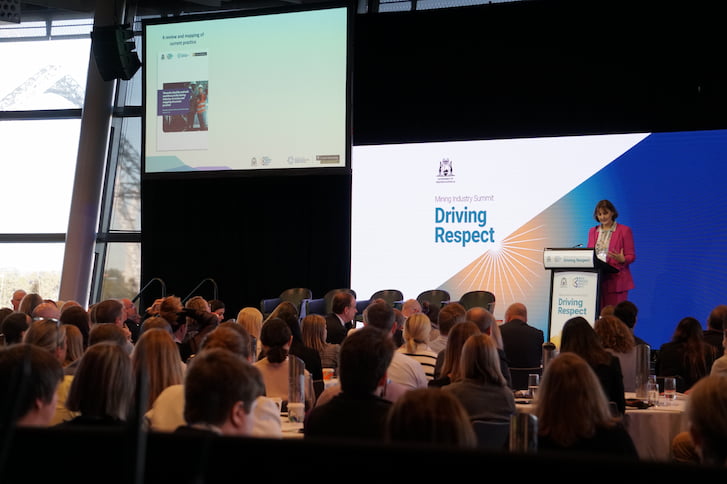
Professor Sharon Parker speaking at the Mining Industry Summit: Driving Respect. Picture credit: Centre for Transformative Work Design
Just over 35% of women and 9% of men in the mining industry say they have experienced sexist hostility in the past 12 months, according to a survey undertaken as part of a Curtin University study. And almost 10% of women and around 3% of men report unwanted sexual attention at work.
“This suggests that more than a third of women are regularly experiencing gender-based, hostile and undermining comments about their abilities, such as comments that women are not suited for mining,” Prof Sharon Parker, from Curtin’s Centre for Transformative Work Design, told the recent Mining Industry Summit: Driving Respect at Optus Stadium.
Parker is heading up a research team looking at health, safety and wellbeing of mining industry workers. The four-year study falls under the WA Government’s Mental Awareness, Respect and Safety (MARS) program.
The workers’ study involved 3200 mining industry workers across 226 companies.
Parker says most at risk of sexual harassment are women, LGBTQI+, younger people and labour hire.
When men experience sexual harassment, it is mostly from their co-workers. However, for women (compared to men), they are more likely to be harassed by senior co-workers, clients and managers.
She also found high levels of harassment “dovetailed with a high level of bullying”.
Nearly 25% of women and 11% of men reported being bullied at least two to three times per month in the past six months at work.
“Witnessing bullying is even higher,” Parker told the audience of more than 1000 human resources, employee relations, mine managers, board members and industry professionals.
“But on the positive side, these numbers are lower than what we reported in the 2018 FIFO [fly-in fly-out] study.”
Where does harassment occur?
Harassing behaviors are more prevalent in workplaces where there is already poor work design, and psychosocial risks and hazards, Parker says.
“Sexist and sexual hostility tends to go alongside a lack of opportunity for development, low role clarity, low job autonomy and excessive surveillance and rules, low support and high job insecurity,” she says.
“These forms of harassment are also more common for women when they are in the minority; that is working alongside all men or mostly men.”
Sexist and sexual hostility is also more likely in unsupported and negative environments under leaders who are uninspiring and aggressive.
“A culture where people feel that the decisions that are made are unjust, that workers can’t trust the grievance procedures, that people will be stigmatised if they raise concerns and a sense that leaders do not care about worker health and safety … these findings suggest that these forms of sexual harassment co-occur with other risks to workers’ mental health and wellbeing,” Parker says.
Moving forward together
Parker says while there have been some improvements, more work needs to be done.
“We need to improve people’s work design and develop a positive culture in which mental health and wellbeing has just as much attention as physical health and wellbeing,” she says.
“We need to address gender inequality in the sector by increasing the number of women, especially in those senior leadership roles.
“We need to actively promote and hold people accountable for respect, for instance, not rewarding and promoting bullies, embedding respect into performance reviews and promotion processes, role modelling respect from the top.”
The full report of the workers’ survey is due out in October.
Our qualified workplace health and safety experts provide cost-effective solutions to manage your WHS needs, reduce the risk to your workers and help you meet WA’s WHS laws. Email [email protected] or call (08) 9365 7415.






